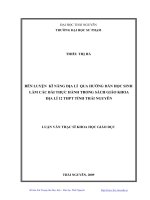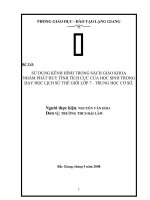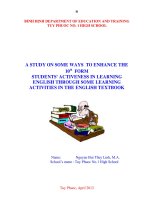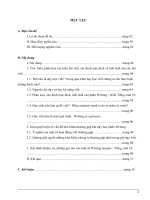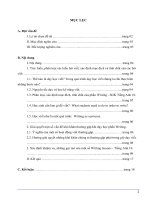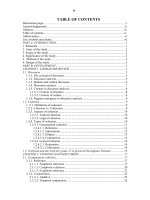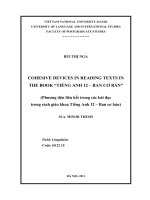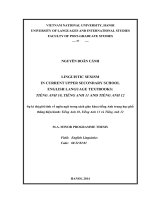Điều chỉnh các nhiệm vụ đọc trong sách giáo khoa “Tiếng Anh 12” cho phù hợp với học sinh có trình độ khác nhau tại trường THPT Vân Nội, Đông Anh, Hà Nội
Bạn đang xem bản rút gọn của tài liệu. Xem và tải ngay bản đầy đủ của tài liệu tại đây (1.95 MB, 67 trang )
Vietnam National University, Hanoi
University of Languages and International studies
Faculty of post- graduate studies
*****
NGUYỄN THỊ TRANG
Adapting reading tasks in the textbook Tieng Anh 12 for
mixed-level students at Van Noi High School in Dong Anh,
Hanoi
(ĐIỀU CHỈNH CÁC NHIỆM VỤ ĐỌC TRONG SÁCH GIÁO KHOA
TIẾNG ANH 12 CHO PHÙ HỢP VỚI HỌC SINH CÓ TRÌNH ĐỘ
KHÁC NHAU TẠI TRƯỜNG THPT VÂN NỘI, ĐÔNG ANH, HÀ
NỘI)
M.A MINOR PROGRAMME THESIS
Field: Methodology
Code: 60 14 10
HA NOI, 2012
Vietnam National University, Hanoi
University of Languages and International studies
Faculty of post- graduate studies
*****
NGUYỄN THỊ TRANG
Adapting reading tasks in the textbook Tieng Anh 12 for
mixed-level students at Van Noi High School in Dong Anh,
Hanoi
(ĐIỀU CHỈNH CÁC NHIỆM VỤ ĐỌC TRONG SÁCH GIÁO KHOA
TIẾNG ANH 12 CHO PHÙ HỢP VỚI HỌC SINH CÓ TRÌNH ĐỘ
KHÁC NHAU TẠI TRƯỜNG THPT VÂN NỘI, ĐÔNG ANH, HÀ
NỘI)
M.A MINOR PROGRAMME THESIS
Field: Methodology
Code: 60 14 10
Supervisor: Phan Thị Hoàng Yến, M.A
HA NOI, 2012
iv
LIST OF ABBREVIATIONS
CUP: Cambridge University Press
OUP: Oxford University Press
LIST OF FIGURES AND TABLES
Table 3.1.: The students‟ awareness of the important role of reading
comprehension
Table 3.2.: The students‟ evaluation of reading lessons
Table 3.3.: Elements affecting the students‟ reading comprehension
Table 3.4.: The students‟ evaluation of the significant role of reading
materials
Table 3.5.: The students‟ perception of the important role of preparation
before class
Table 3.6.: The students‟ habit of doing reading tasks
Table 3.7.: The students‟ opinions about working in groups
Table 3.8.: The students‟ preference for the way of working in groups
Table 3.9.: The students‟ opinions about the language in the reading texts
Table 3.10.: The students‟ opinions about the content of the reading texts
Table 3.11.: The students‟ opinions about the reading tasks
Table 3.12.: The students‟ preferences for reading tasks
Table 3.13.: The students‟ response to the adapted tasks and group work for
Unit 12
Table 3.14.: The students‟ response to the adapted tasks and group work for
Unit 14
v
TABLE OF CONTENTS
Declarations i
Acknowledgements ii
Abstract iii
List of Abbreviations iv
List of Tables and Figures iv
Table of Contents v
PART I: INTRODUCTION 1
1. Rationale of the study 1
2. Aims of the study 1
3. Research questions 2
4. Significance of the study 2
5. Scope of the study 2
6. Methods of the study 2
7. Design of the study 4
PART II: DEVELOPMENT 5
Chapter One: Literature review 5
1. Overview on reading theories, task, task adaptation, and group
practice 5
1.1. Definition of reading comprehension 5
1.2. Role of reading in foreign language learning 5
1.3. Challenges of comprehending reading texts 6
1.3.1. Reading ability 6
1.3.2. Language proficiency 6
1.3.3. Cultural and background knowledge 7
1.4. Reading skills 7
1.5. Task adaptation as a type of support for the reading comprehension
process 8
vi
1.5.1. Task definition 8
1.5.2. Adaptation definition 9
1.5.3. Purposes of adaptation 9
1.5.4. Categories of adaptation 9
1.6. Grouping practice 10
1.6.1. Benefits of grouping 10
1.6.2. Grouping techniques 11
1.6.3. Management of group work 11
1.6.3.1. Numbers of students in one group 11
1.6.3.2. Leadership in one group 12
1.6.3.3. Time setting 12
1.6.3.4. Monitoring of group work 12
1.6.3.5. Evaluation and assessment of group work 12
Chapter Two: The study 13
2.1. Situation analysis 13
2.1.1. Setting of the study 13
2.1.2. The learners 13
2.1.3. Reading materials 13
2.2. Instrumentation and Procedures 14
2.2.1. Instrument 1: Preliminary survey 15
2.2.2. Instrument 2: Survey questionnaire 15
2.2.3. Instrument 3: Class observation sheets 15
2.2.4. Instrument 4: Survey for response to adaptation and working in
groups 15
2.3. The grouping of the students 16
2.4. The adaptation of reading tasks in the textbook Tieng Anh 12 16
Chapter 3: Data analysis 21
3.1. Data analysis of preliminary survey 21
3.1.1. Personal information of the students taking part in the survey 21
vii
3.1.2. The students‟ awareness of reading comprehension in general 21
3.1.2.1. The students‟ awareness of the important role of reading
comprehension in learning English 21
3.1.2.2. The students‟ evaluation of reading lessons in terms of
their interests 21
3.1.2.3. The students‟ perception of elements affecting their
reading comprehension 22
3.1.2.4. The students‟ evaluation of the important role of reading
materials to their interests 22
3.1.3. The students‟ ways of learning reading lesson 23
3.1.3.1. The students‟ perception of the important role of
preparing vocabulary and reading texts before class 23
3.1.3.2. The students‟ habit of doing reading tasks 23
3.1.4. The students‟ opinions about working in groups 24
3.2. Data analysis of survey questionnaire 24
3.2.1. In terms of language 25
3.2.2. In terms of content 25
3.2.3. In terms of reading tasks 26
3.2.4. The students‟ suggestions for the teacher‟s adaptation of
reading tasks 28
3.3. Data analysis of survey questionnaire for response to adaptation and
working in groups 31
3.3.1. Data analysis of response to task adaptation and group work of
Unit 12 32
3.3.2. Data analysis of response to task adaptation and group work of
Unit 14 33
3.4. Reflection 34
Chapter 4: Major findings and suggestions
4.1. Major findings and discussion 37
viii
4.2. Suggestions 40
PART III: CONCLUSION 44
1. Conclusion 44
2. Limitations and recommendations for follow-up action 45
REFERENCES
APPENDIXES
Appendix 1: Preliminary Survey I
Appendix 2: Survey Questionnaire III
Appendix 3: Worksheets (delivered in class) V
Appendix 4: Samples of Adapted Reading Tasks VIII
Appendix 5: Survey for Response to Adaptation and Working in Groups XI
Appendix 6: Reading passages and original reading tasks (Unit 12 & Unit
14) XII
1
PART I: INTRODUCTION
1. Rationale of the study
In Exploring second language reading: issues and strategies by Anderson
(1999: 1), he affirms that reading is indispensable to learning a second or a foreign
language. Once a learner has acquired the skill, he/ she can achieve academic
improvement. Despite that importance, the students at Van Noi High School, where
the researcher has been teaching English for more than seven years, pay little
attention to the skill as well as the reading texts and reading tasks in their textbooks.
From the result of a survey conducted by the researcher, the reasons for that
problem include the students‟ depreciation of English, their poor knowledge of
English, and their avoidance of learning English. What should be done to solve that
problem has tormented the researcher and she has thought a lot to find out an
answer. On the way of doing that, she has also taken into consideration one more
fact that the students are not at the same level. With the same reading tasks, some
feel bored as they are easy; some feel depressed because they are too difficult.
Therefore, she wonders whether she should make groups of similar-level students,
and adapt the designed reading tasks in the textbook to make them more suitable for
each group. It also means that each group requires a different reading technique to
fully exploit one reading text to the most of their ability. That can be considered the
best the author can do for her students as a teacher and within this minor thesis.
Other solutions related to students‟ proficiency and personality, learning and
teaching equipments are almost time-consuming and beyond the teacher‟s power of
control.
All the things above have driven the researcher to doing this study with the
hope that she can help the mixed-level students get more knowledge and improve
their reading skill through the adaptation of reading tasks in their textbooks.
2. Aims of the study
The study was designed to help mixed-level grade-12 students work harder
on reading texts, get more reading comprehension and improve their reading skill
2
through the adaptation of reading tasks in the textbook Tieng Anh 12 for different
groups of similar level.
The study is aimed to achieve three objects:
1. To investigate how the students learn the reading text and do the reading tasks.
2. To make some suggestions of adapting reading tasks in the textbooks for
groups of students.
3. To investigate how the adaptation works for the students and whether group
work is effective in learning reading.
3. Research questions
In order to achieve the above-mentioned aims, the following research
questions guided the study:
1. How do the students often do the reading tasks in their textbooks? Why?
2. In what way can the tasks be adapted to help them get more knowledge
and improve their reading skill?
3. Does working in groups help them learn more effectively?
4. Significance of the study
The study was carried out to encourage the students‟ assessment of reading
tasks in the textbook. The unsuitable tasks were adapted to be more accessible for
the mixed-ability students. Pedagogically, the findings of the study are believed to
bring about necessary changes in reading materials and teaching methodology to
improve the students‟ reading comprehension at Van Noi High School.
Furthermore, the suggestions for teaching reading based on the findings can
be useful for concerned teachers to make reading lessons more interesting and
effective.
5. Scope of the study
Materials adaptation is such a broad topic that it cannot be wholly discussed
within the framework of this paper; therefore, only one specific aspect will be
central to the reading tasks‟ adaptation.
With the focus on reading tasks only in the textbook Tieng Anh 12 (the basic
3
textbook), the study was carried out to adapt those for groups of students of similar
ability.
The study focuses on one class of grade-12 students, so the results of the
study are not applied for all students at Van Noi High School.
6. Methods of the study
The study in fact is a mini action research. According to Nunan (1992: 19),
an action research includes seven steps. They are: initiation, preliminary
investigation, hypothesis, intervention, evaluation, dissemination and follow-up.
The applied steps in details are as follows:
Step 1- Initiation: In the process of teaching the textbook Tieng Anh 12, the author
observed that the students did not take reading lessons seriously, they often
participated in those lessons inactively and inefficiently meanwhile reading
comprehension was considered important to academic studies. What should be
done?
Step 2- Preliminary investigation: The author carried out the preliminary survey to
find out how they often prepare and learn reading lessons.
Step 3- Hypothesis: By collecting and reviewing the baseline data, the author came
to the hypothesis that the students were reluctant to learn reading lessons because
they often encountered problems with language, reading strategies, background
knowledge and motive to learn.
Step 4- Intervention: Before each new unit, the students were surveyed to find out
their opinions about the topic and reading tasks in the coming lesson. After
collecting the results, the author grouped the students of similar ability and adapted
suitable tasks for each group. The adapted tasks were delivered in the next lesson.
The author observed the class and recorded the results. When the students finished
the tasks, the author provided them with survey questionnaires for response to
adaptation and group work.
Step 5- Evaluation: The students found the adapted tasks less challenging and
achievable. They were more comfortable when doing those tasks in groups of
4
similar-ability groups and took part in reading lessons more actively. However,
there were some goof-offs in groups after three periods of working in groups.
Step 6- Dissemination: The author discussed the effectiveness of adapted tasks and
group work to the students.
Step 7- Follow-up: The author suggested more adapted activities and grouping to
teach other reading lessons basing on the textbook Tieng Anh 12 to the students.
7. Design of the study
The study titled Adapting reading tasks in the textbook Tieng Anh 12 for
mixed-level students at Van Noi High School in Dong Anh, Hanoi consists of three
main parts namely Introduction, Development and Conclusion.
In the first part, Introduction, the reason for the research, aims, significance,
scope and methodology of the study are mentioned.
The second part, Development, contains four chapters.
- Chapter One focuses on theoretical background of the study which is
about reading tasks, task adaption, and grouping students.
- Chapter Two not only describes the context of teaching and learning
English at Van Noi High School but also presents the instrumentation of the
study, the adaptation of reading tasks and the grouping of students.
- Chapter Three deals with a comprehensive data analysis.
- Chapter Four reports major findings, discussion, and suggestions.
The last part, Conclusion, provides a summary of the study, limitations and
recommendations for follow-up action.
5
PART II: DEVELOPMENT
CHAPTER ONE: LITERATURE REVIEW
This chapter aims at providing a theoretical background knowledge relating
to reading comprehension, task adaptation and grouping students for the study.
1. Overview on reading theories, task, task adaptation, and grouping practice
1.1. Definition of reading comprehension
Reading, according to Williams (1984), is simply “a process whereby one
looks at and understands what has been written” (p. 2). His idea is shared in Ur
(1996: 38) that “reading means reading and understanding.” Karlin and Kartin
(1988:2) also express that “reading without reading comprehension is meaningless.”
In light of these above definitions, only reading is not considered „reading‟ without
understanding.
Reading comprehension and understanding are used interchangeably
(Grellet, 1981: 3; Richard and Thomas, 1987: 8). They identify the two terms when
they define reading comprehension as “an understanding between the author and the
reader.” Clearly, according to these authors, reading comprehension is not simply a
process where a reader knows what an author intends but a process whereby
readers‟ ideas, experiences and responses are stimulated.
In summary, reading comprehension is a sophisticated process in which the
reader uses his knowledge, experiences and strategies to get meaning of the text.
Also, in this process, we should mention the activity of reading which includes
purposes, processes and consequences associated with reading.
1.2. Role of reading in foreign language learning
Reading is said to be “by far the most important of the four skills in a second
language, particularly in English as a second or foreign language” Carrel (1981:1).
Anderson (1999:1) stresses a connection between reading and academic success:
“with strengthened reading skills, ESL/EFL readers will make greater progress and
attain greater development in all academic areas.” Besides, reading is the only way
to help a learner “acquire a large vocabulary, develop the ability to understand and
6
use complex grammatical constructions, develop a good writing style, and become
good (but not necessarily perfect) spellers” Krashen (1993:84). In other words,
reading helps learners have good command of English. Thus, it is essential for
English teachers to develop learners‟ reading comprehension in general and enhance
vital reading skills in particular.
1.3. Challenges of comprehending reading texts
Much research has documented three main factors language learners
encounter in reading. They are: (1) reading ability, (2) language proficiency and (3)
cultural and background knowledge.
1.3.1. Reading ability
Many scholars have found a correlation between reading in the learner‟s
mother tongue and in a foreign language. Bernhardt and Kalmil (1995:7) affirm that
“reading performance in a second language is largely shared with reading ability in
a first language”. Alderson (1984) also blames learners‟ failure in reading English
on their poor native language reading. In fact, a number of learners do not know
how to read, even in their first language. They often choose to read slowly from the
beginning to the end. This habit makes them fail to concentrate on the text and grasp
the general meaning if they encounter new words, new structures or new topic when
they read in a foreign language. As a result, they lose their interest in reading. To
solve this problem, only suitable strategies and skills for making use of lexical,
grammatical, logical and cultural clues can help.
1.3.2. Language proficiency
Language proficiency in the field of reading can be understood as knowledge
of vocabulary and grammatical structures. If a learner‟s language competence is
low, it is “one of the obstacles to text comprehension” (Levine and Reves, 1990: 37;
cited in Anderson, 1999: 25). Yorio (1971: 108) also regards the imperfect
knowledge of the target language and the mother tongue interference as the major
cause of failure in reading a foreign language. It has been observed that learners are
unmotivated when they read a text about a difficult topic and it contains too many
7
unfamiliar words. They find it hard to interpret the meaning of the text, even when
they look up a dictionary to find meanings of words. Obviously, low competence of
the language prevents learners from exploring reading texts.
1.3.3. Cultural and background knowledge
It is clear that reading comprehension is not simply an activity of
understanding words, sentences or texts. Rather, it is much more complex, and it is
“an interactive process that requires consistent inferring and guessing” (Qian
Huang, 2009). Why is reading comprehension an interactive process? The
relationship between the text and the reader explains. Texts affect readers through
words, content and structures while readers use their background knowledge to
understand texts.
Background knowledge, or prior knowledge of readers helps them make
predictions about the meaning of the text. This occurs when readers activate their
life experience, educational experience, etc. to connect things they already know
with what they are reading in the text. Accordingly, if readers have relevant
knowledge about one topic, they can understand that reading text more easily and
more profoundly.
There have been several researches on the positive effects of cultural
similarity on reading comprehension (Alptekin: 2006; Steffensen, Joag-Dev, &
Anderson: 1979) and vocabulary learning (Pulido: 2003 & 2004) (cited in Ismail
Hakki Erten and Salim Razi:2009). Firstly, it facilitates comprehension. Because
cultural similarity “nativizes” the text, making it easier for students to “construct
mental representations of the familiar context.” Secondly, cultural similarity also
helps raise motivation in readers. When they find their local environment in
reading texts, they are more engaged in reading, thus they understand the text
more deeply. Therefore, without the relevant cultural knowledge, readers cannot
fulfill their reading activities to the full.
1.4. Reading skills
According to Mikulecky (1990), the reading process involves twenty-four
8
skills such as automatic decoding, previewing and predicting, scanning,
skimming, paraphrasing, summarizing, etc. These skills are too many to teach at
one time. Thus, the author also contends that focusing on one reading skill at a
time is more effective and teachers should give some examples of using that skill.
She believes that students will gradually deploy the skill unconsciously and
strategically.
However, in the Teacher‟s Manual by MoET (2006), only four reading
skills should be stressed at high school level: extensive reading, intensive
reading, scanning and skimming. In the teaching context of Van Noi High
School, when the grade-12 students are under a lot of learning pressure for their
entrance examination, the two skills of extensive and intensive reading are not
paid much attention, but for the last two: scanning and skimming.
1.5. Task adaptation as a type of support for the reading comprehension
process
1.5.1. Task definition
As cited in Richards and Rogers (2001: 223), Breen (1987: 26) writes: “a
language learning task can be regarded as a springboard for learning work. In a
broad sense, it is structured plan for the provision of opportunities for the
refinement of knowledge and capabilities entailed in a new language and its use
during communication.” More explicitly, Prabhu (1987: 17) defines a task as “an
activity which requires learners to arrive at an outcome from given information
through some process of thought, and which allows teachers to control and regulate
that process.” From the two definitions, it is clear that a task attaches special
importance to completeness or outcome of learning process.
In the context of teaching reading comprehension, Scrivener (2005: 188)
concretizes a task by recommending a framework of 15 specific reading tasks such
as reordering, listing, responding, problem solving, predicting, etc. This framework
of tasks is really helpful in developing students‟ micro-reading skills, so this study
uses the “reading comprehension tasks” concept with reference to this framework.
9
1.5.2. Adaptation definition
According to Tomlinson (1998: xi), adaptation is “making changes to
materials in order to improve them more suitable for a particular type of learner.” In
the aspect of adaptation techniques, Madsen and Bowen (1978: ix-xi) mentions
adaptation as the action of employing “one or more of a number of techniques:
supplementing, editing, expanding, personalizing, simplifying, modernizing,
localizing, or modifying cultural/ situational content.” Differently, Stevick (1972),
cited in Mc Donough and Shaw (1993: 83) emphasizes teachers‟ role of bridging a
gap between materials and learners: “the teacher must satisfy the demand of the
textbook, but in ways that will be satisfying to those who learn from it.”
In brief, adaptation requires teachers to change and revise materials to make
them more accessible to the teaching context.
1.5.3. Purposes of adaptation
The first purpose of adaption emerges from the fact that learning materials
are not always in congruence with the learners‟ needs and societal requirements;
they usually contain outdated information, linguistic inaccuracies, lack of
authenticity or lack of variety, so syllabus and curriculum needs to be revised
(Madsen and Bowen‟s, 1978).
The second purpose of adaptation is to “maximize the appropriacy of
teaching materials in context, by changing some of the internal characteristics of a
course book to better suit our particular circumstances” (Mc Donough and Shaw,
1993: 85). A teacher may resort to any method to adapt the teaching materials to
make them more relevant, accessible and useful for learners, which can stimulate
and increase motivation in learners and create a more conductive learning
atmosphere in the classroom.
1.5.4. Categories of adaptation
There are a variety of adaptation techniques a teacher can apply when
teaching reading with a hope to help learners to make maximum use of their
textbooks and learn as much of the target language as possible.
10
Within the scope of this study, the author would like to discuss some
frequently-used techniques with regard to the discussions of McGrath (2002) and
McDonough and Shaw (1993). These scholars all refer “adaptation” to some
techniques of change and addition.
McGrath (2002) divides adaptation techniques into two categories:
adaptation as addition and adaptation as change. The forms of extemporization,
extension, and exploitation are included in the former. The latter is concerned with a
principled approach to adaptation, and foci and change forms (pp. 64- 67).
Similarly, McDonough and Shaw (1993: 36) consider “external and internal
criteria” for adaptation. They claim that tasks can be localized, personalized and
individualized. Accordingly, teachers can decide to add, to delete, to modify, to
simplify or to reorder the tasks, depending on teachers‟ purpose of language practice
or text skills, etc. However, this framework consists of just five different techniques,
which does not fully reflect the complexity of the classroom and the diversity of
textbook in use.
1.6. Grouping practice
1.6.1. Benefits of grouping
Grouping is common practice in a language teaching class. The two most
common forms of grouping are within-class grouping and between-class grouping.
In the scope of this study, the author is only concerned with the former: within-class
grouping.
Research has documented that grouping benefits students‟ outcome. Cited by
Vaughn, Hughes, Moody, and Elbaum (2001), Maheady (1997) considers grouping
as one of the alterable instructional factors that "can powerfully influence positively
or negatively the levels of individual student engagement and hence academic
progress." Sharing the same view, Sue Stepp (2012) notes that “When students
work in groups on projects, the students learn cooperatively.” Furthermore, Dr.
Kizlik adds one advantage of grouping students: “placing students into groups to
maximize the effectiveness of an instructional technique can be a powerful tool for
11
both teaching and classroom management.” However, he stresses that the practice
should be done with careful planning and thought; otherwise, it can “lead to
inefficient use of teacher and student time.” That is what teachers should keep in
mind when grouping students and what goes on in the next part.
1.6.2. Grouping techniques
Teachers may have several ways of grouping students, including interest
grouping, ability grouping, random student grouping and student choice grouping
(Wagaman, 2008). Shalaway (2005) agrees with Wagaman on the four techniques,
and adds four more: social (cooperative) grouping, task grouping, knowledge of
subject grouping, and skill/strategy grouping. Four ways of grouping like
Wagaman‟s are also recommended by Michaelsen (1999) but he lists heterogeneous
grouping instead of student choice grouping. Each technique has both advantages
and disadvantages, so teachers should use different grouping formats flexibly basing
on such criteria as students' skills, prior knowledge, or interest (Valentino, 2000).
Of all the mentioned techniques, the author prefers ability grouping. The
advantage of this technique has been discussed in some researches. „The Balanced
view‟, a research by Westchester Institute For Human Services Research takes a
close look at the issue of ability grouping and concludes that “Within-class ability
grouping plans benefit students of all ability levels”. Jenn (2012) explains more
explicitly that when we group higher-achieving students in one group, they can do
one task at a faster speed. Meanwhile, lower-achieving students have more chances
to move more slowly and the teacher can help them to solve their problems.
Moreover, she also adds “homogeneous groups also help you to lessen frustration
levels for lower achievers who struggle to keep up with higher achievers.”
Therefore, the technique of like ability grouping will be applied most of the
time in this study. However, whole-class group or individual work will be also
managed during different stages of a reading lesson.
1.6.3. Management of the group work
1.6.3.1. Numbers of students in one group
12
Many scholars recommend a range of three to five people in one group to
ensure the workload is evenly distributed among group members (Breslow: 1998,
Jens: 2012, Stepp: 2012, at al.) However, it is fine to make groups larger if there is a
pedagogical reason.
1.6.3.2. Leadership in one group
Stepp (2012), and Filipowich (2012) both advise appointing a team leader to
assign tasks to each member and share the management of the group work with the
teacher.
1.6.3.3. Time setting
An unknown contributor at />classroom-group-work.html suggests that time limits be given to encourage all the
groups to work quickly to meet the deadline.
1.6.3.4. Monitoring of group work
From an unknown contributor at
an idea
is developed that the teacher should go as quickly as possibly between groups to
make sure that all the students are working, and he should try to engage those who
are falling out of the group‟s discussion.
1.6.3.5. Evaluation and assessment of group work
Jenn (2012) suggests periodic evaluations throughout the assignment. If
groups of students work on a long-term basis, the teacher should frequently check
whether those students stay on tasks and make adequate progress. She also gives
suggestions on how to assess groups. She writes that we can assess groups both as a
whole and individually. When teachers give grades to group work, they should bear
in mind not only individual performance and collaborative products. By evaluating
and assessing group work by both individual and group levels, teachers can ensure
that “individual accountability remains high, while group cohesion to reach the final
goal remains strong.”
13
CHAPTER TWO: THE STUDY
This chapter will analyze the situation of the study with the description of the
subjects, the materials used by the students, the grouping of the students and the
instruments applied to collect data.
2.1. Situation analysis
2.1.1. Setting of the study
The study was conducted at Van Noi High School in Dong Anh, the suburb
of Hanoi City. At Van Noi high school as well as other high schools all over the
country, English is one of the three compulsory core subjects in the national
examination for GCSE (General Certificate of Secondary Education).
The students have three 45-minute periods of English a week, that is, 51
periods in term 1 and 54 periods in term 2. However, there are only seven reading
lessons in each term.
2.1.2. The learners
The study was carried out with the participation of 41 students of class 12G,
specialized in natural science subjects (Maths, Physics and Chemistry). In general,
the students are at the age of 18. There are 26 girls and 15 boys. They all live in
Dong Anh District. All of them have learnt English since they were at grade 3, but
most of them have almost nothing about English in their mind. They do not pay
much attention to studying English but they hope to be able to learn it after they
have passed their entrance examination for their favorite university.
At the time of the study, the students were in their second term of the school
year. The second term began with Unit 10.
2.1.3. Reading materials
The textbook Tieng Anh 12, edited by Hoang Van Van and written by Hoang
Thi Xuan Hoa, Dao Ngoc Loc, Vu Thi Loi, Do Tuan Minh and Nguyen Quoc Tuan,
published by Nha xuat ban giao duc, is a theme-based textbook, and a continuance
of the textbooks Tieng Anh 10 and Tieng Anh 11. It is intended to provide students
with thorough coverage of basic grammatical and lexical items and language skills.
14
The textbook is used for grade-12 students. It consists of 16 units. However,
in this school year, the Ministry of Education and Training has omitted two of them
(Unit 7 and Unit 9). Each unit has one reading lesson. All the reading lessons in the
textbook follow three stages of pre-reading, while-reading and post-reading. The
reading texts are not too difficult. They are intended to be suitable for all levels of
students. However, they are not challenging enough for good students and beyond
slow students‟ level.
2.2. Instrumentation and Procedures
The data collected from „student-based evaluation’ and „response-based
evaluation’ (Ellis, 1997: 39-40) helps conduct this mini action research. The former
was to check whether the reading tasks are useful, based on the students‟ attitudes to
the reading tasks. Thus, the data was practical and reliable. Doing the later, the
teacher had to see whether the actual outcomes matched with the students‟
motivation and teaching objectives by examining not only the products but also the
processes of the tasks.
Questionnaires were utilized as the main data collection instruments and
class observation was functioned as a supplementary source of information.
Because all the informants answered the same questions, the data collected were
easy to summarize, analyze and report. Furthermore, the subjects were free to give
their ideas without having to provide personal information. For that reason, the
researcher has more uniform and accurate data.
To avoid misunderstanding and ensure the accuracy of the data, both types of
questionnaires were written in Vietnamese and distributed with the author‟s clear
explanation.
The researcher let the participants read the texts before hand and let them
respond to a survey questionnaire one period before each reading lesson, and set
aside 15 minutes after each reading lesson so that they were not under pressure of
time.
The instrument and procedures used to gather the information for the study
15
will be described as follows:
2.2.1. Instrument 1: Preliminary Survey
The Preliminary Survey Questionnaire (see Appendix 1) was delivered to the
students at the beginning of the second term, after they have finished first term. It
was designed with four parts. Part 1 seeks information about students‟ sex, time of
learning English and English result of the previous semester. Part two consists of
four questions finding the students‟ general attitudes towards: the role of reading
comprehension (Question 1), reading lessons (Question 2), elements affecting
reading comprehension (Question 3), and the role of reading materials to their
interests (Question 4). Part three includes two questions learning about the way the
students often do their reading lessons. Part four investigates whether the students
like working in groups or not and how they would like to work in groups.
2.2.2. Instrument 2: Survey Questionnaire
This questionnaire (see Appendix 2) was designed with four parts of open
and closed questions. It was delivered one day before each new reading lesson and
after the teacher had asked the students to read the reading passage and its tasks
beforehand. It is aimed at finding out the students‟ opinions about the reading texts
in the aspects of content, language, and reading tasks in each unit.
2.2.3. Instrument 3: Class Observation Sheets
The class observation sheets were used to note down the students‟
performance in classroom. This was a useful tool to measure the students‟ attitudes,
behavior and interaction when working in groups, dealing with adapted tasks.
2.2.4. Instrument 4: Survey for Response to Adaptation and Working in groups
One survey for response to adaptation and working in groups (Appendix 5)
was given to the students after each reading lesson to see how effective the adapted
tasks were and their group work was. The follow-up questionnaire has six
questions. The students were asked to self-rate their seriousness in preparing the
lesson and doing the tasks as well as the effectiveness of their group work and the
adapted tasks.
16
2.3. The grouping of the students
After teaching the students for one semester and collecting data from the
preliminary survey, the author could easily identify the students of similar ability
and their preference for their group members. Therefore, eight groups of 5- 6
students were formed, based on ability level as well as the students‟ wish. The
students were allowed to name themselves, and eight interesting names were given:
Angles, Happy Dream, Devils, N7, Number 1, Super Star, Naive fox, and DLT. In
each group, one leader and one secretary were appointed. They took the
responsibility for promoting the group work and taking notes of the group‟s answers
respectively. Of the eight groups, Naive Fox (6 members) and Super Star (5
members) included the best students in the class, and the last six groups (5 members
each) consisted of all low-achieving students in the class.
The forming of similar ability groups could help the author design suitable
tasks for each group in the hope of giving the students more success in reading
English. However, to ensure the success of the reading lesson, a lot of preparation
was compulsory before each reading lesson. The students were asked to prepare
vocabulary and all the reading tasks in the textbooks and the tasks given to them in
classroom were to check whether they had done their work seriously and enlarge
new aspects of the reading texts.
2.4. The adaptation of reading tasks in the textbook Tieng Anh 12
Basing on the findings from the students‟ statement of the way they often do
their reading and their evaluation of reading tasks, some adaptation techniques were
employed to force the students to work more seriously and make the tasks more
accessible to them. The tasks of Unit 12 and Unit 14 were adapted, using common
adapting techniques such as „modifying, reordering, replacing and simplifying’.
Sample of adaptation
1. Unit 12 (Page 128, the textbook Tieng Anh 12)
* Sample 1.1.: Modifying
For high-achieving students (see Appendix 4, sample 1.1)
17
Rationale for adaptation
The reading section of Unit 12 (see Appendix 6) was regarded a difficult one
because the text describes an unfamiliar sport to the students. Thus, the adapted
version of tasks 2 and 3 in the textbook was modified to the two groups of high-
achieving groups.
Adapted version:
- Type of activity: individual and group work
- Aims: to give the students a general idea of how a game of water polo is
played
- Task: while-reading task
- Preparation: the students have to prepare color pens and the teacher
prepares one worksheet for each student
- Time: 15 minutes
- Procedure:
+ After finishing pre-reading tasks with the whole class, the two
groups received worksheets from the teacher to draw a pool where people
could play water polo and tell what the players can do
+ The students had to do individual work first, then share in each
group. The secretary in each group had the responsibility to choose the best
picture of the group and the best description to hand in.
+ The teacher observed the group work, and gave help if necessary.
+ The teacher took suggestions from each group for one student who
would get mark 10 for his/ her excellent contribution to group work.
+ The teacher took the worksheets home and returned them next time.
* Sample 1.2.: Modifying
For the six low-achieving groups (see Appendix 4, sample 1.2)
Rationale for adaptation
The students in these six groups are not very good at English and they are not
motivated to learn the subject. According to information collected in the
18
Preliminary survey, they often do the reading tasks reluctantly by copying others‟
work or copying answers from „De hoc tot Tieng Anh 12‟ and rarely bother to read a
sentence in the reading passage. If they do, they say that they read every word in the
reading passage and hardly understand anything because there are too many new
words for them. Thus, the author had to change the questions so that they had to
read the text very fast to find specific pieces of information to answer the questions.
Adapted version:
- Type of activity: individual and group work
- Aims: to help the students practice scanning skill
- Task: while-reading task, answering comprehension questions
- Preparation: one copy of the worksheet for each student
- Time: 15 minutes
- Procedure:
+ After finishing pre-reading tasks, the six groups received
worksheets from the teacher to answer the comprehension questions.
+ The students read the text and answered the questions individually
first, then they shared their answers in groups. The leader had to control the
group work (he had to make sure that every member worked seriously), and
the secretary was responsible for collecting ideas from the group members to
make a complete answer sheet to hand in.
+ The teacher went round to observe and give help if necessary.
+ After 15 minutes, the teacher took the suggestions from the groups
for the student who would get mark 10.
+ Then the teacher checked the answers with the six groups.
2. Unit 14 (page 152, the textbook Tieng Anh 12)
Rationale for adaptation:
From the result of the survey before the lesson, the topic of the text is
uninteresting to the students and it contains many difficult words. Because the
following tasks are not only difficult but also boring to the students, task 2 and task
